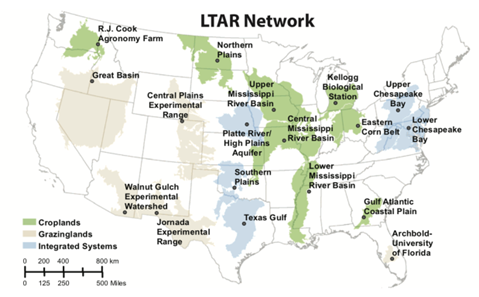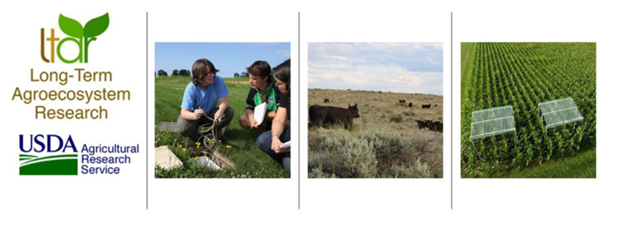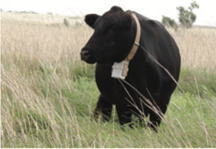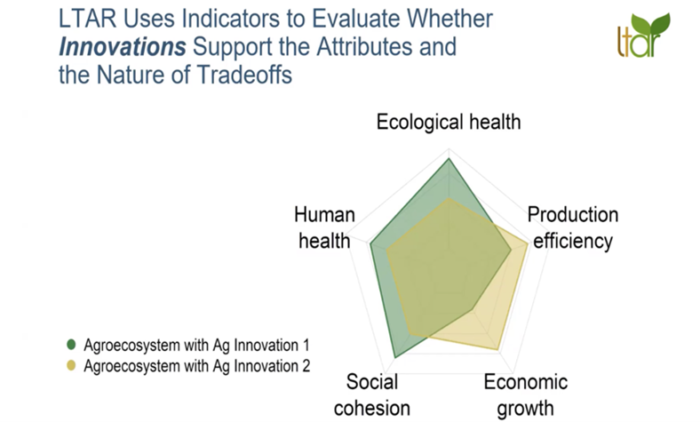Many may not be aware that the United States Department of Agriculture (USDA)’s Long-Term Agroecological Research (LTAR) network, managed by the Agricultural Research Service (ARS), works to address a range of regional and national agricultural challenges. Created in 2012, this one-of-a-kind network of 18 research sites across the country engages producers and other stakeholders in the development, design, and implementation of research innovation that has helped improve the long-term productivity and prosperity of agricultural communities.
Last month the National Sustainable Agriculture Coalition (NSAC) along with the American Institute of Biological Sciences (AIBS), and the Society for Range Management, co-sponsored a virtual briefing to feature the ground-breaking research of LTAR scientists. The LTAR network, which features a range of major agricultural systems including row crops, rangelands, and integrated crop and animal systems, helps farmers and ranchers overcome productivity challenges while improving environmental stewardship. Its work focuses on improving agricultural sustainability by finding solutions to improve productivity, increase rural prosperity, and support ecosystem services, soil health, biodiversity, and water quality.

Tools, technologies, and management practices emerging from the long-term research of the LTAR network, include new production techniques, genetics, and sensor infrastructure. This is applied at the farm/ranch level to increase the how farmers adapt to changing management practices, reduce time and operational costs, and increase their profits and quality of life. The LTAR network operates in four (4) major ways:
- Coordinating Research across sites to better understand how agroecosystems function at the field, regional, and national scales.
- Managing information by making data available to the public, and bringing real-time management technologies to producers.
- Understanding and Managing New Tools and Technologies like remote sensing, computer modeling, and web technologies to help producers make informed decisions both on and off-site.
- Building Partnerships with Agricultural Stakeholders by engaging producers and other stakeholders to understand ongoing needs and increase the utility and adoption of new information and technologies.
Some of the many research topics covered in the LTAR network include conserving water resources, improving nutrient efficiency and soil health, livestock management, and cover crops. The virtual briefing, held on May 11, 2022, highlighted the work of four ARS scientists working within the LTAR network.
Speaker Highlights

Stephen Mirsky, PhD, a research ecologist at USDA’s Sustainable Agricultural Systems Laboratory in Beltsville, Maryland, underscored the importance of coordinating transdisciplinary research, effective computation resources, and low-cost technologies to deliver tools to farmer that enable them to make real-time decisions and plan long-term. Dr. Mirsky uses computer vision and artificial intelligence, along with low-cost sensing technologies to quantify the impact of climate, soil, and management practices on productivity and sustainability.
Dannele Peck, PhD, director of USDA’s Northern Plains Climate Hub in Fort Collins, Colorado, led an interesting conversation about the relationship between grassland ecosystems, beef, and birds. Specifically, her research looks at how grazing cattle can be managed to help provide habitat for birds with diverse habitat needs. Dr. Peck works with a team of bird conservation groups, ranchers and public land managers to explore how grassland systems can be maximized to provide service for both livestock and native species.

Peter Kleinman, PhD, research leader for USDA’s Soil Management and Sugarbeet Research Unit in Fort Collins, Colorado, addressed the critical need to reduce nutrient pollution and safeguard natural resources. Dr. Kleinman introduced the concept of manuresheds – a circular management of nutrients that recouples crop and livestock systems to help return the unconsumed nutrients in the manure to cropland areas to grow more feed, and thus reduce nutrient runoff. Dr. Kleinman has also spearheaded comprehensive research in developing and evaluating novel manure application technologies and contributed to the development of new filtration technologies to remove phosphorus from manures and runoff waters.

Sheri Spiegal, PhD, a range management specialist at the Range Management Research Unit in Las Cruces, New Mexico, rounded out the panelists with her presentation on the importance of performance indicators on crop and grazing lands. Indicators include ecological and human health, production efficiency, economic growth and social cohesion that help evaluate whether innovations and other outcomes support the attributes and nature tradeoffs of the tools and methodologies emerging from new research. Her ongoing research focuses on understanding the effects of agricultural management strategies on environmental economic and social sustainability outcomes.

Opening remarks were provided by Teferi Tsegaye, PhD, National Program Leader for USDA’s LTAR Network, as well as the Water Availability and Watershed Management program. Brandon Bestelmeyer, PhD, research leader at USDA’s Range Management Research Unit, served as moderator.
Supporting the LTAR network
NSAC is an avid supporter of LTAR’s mission and its dissemination of research to farmers. The current 18 sites were placed under the umbrella of the LTAR network to work together to address national and local agricultural priorities. Operating on a tiny budget of about $20 million per year, many of these sites remain underfunded, putting a strain on the quality and quantity of research outcomes at these sites. Underfunded ARS sites include the Lower Chesapeake Bay site in Maryland, the Kellogg Biological Station in Michigan, the Upper Mississippi River Basin site in Minnesota, the Lower Mississippi River Basin site in Mississippi, and the Eastern Corn Belt site in Ohio.
Adding to this complexity is that the LTARs are not currently authorized in statute. This means that funding for the network is not guaranteed. Sites that have been successful at securing funding have done so if their member of Congress has specifically requested funding for those sites. Establishing legislative authority for the LTAR network would go a long way to ensure funding can be directed annually to each site.
The Agriculture Resilience Act (ARA), first introduced by Rep. Pingree (D-ME) in 2020, provides a first-ever legislative authorization for the LTAR Network at $50 million per year. In addition, the ARA would (1) establish climate change adaptation and mitigation as major statutory purposes of the LTAR network, (2) integrate measurements and data collection across LTAR sites to enhance understanding of agroecosystem function in all major US agricultural regions and production systems, and (3) make data collected through the network openly available to researchers and the public. By establishing a legislative authority for $50 million a year and affirming climate mitigation and resilience as top priorities, the ARA would substantially strengthen the capacity of the LTAR Network to help producers and our food system meet the challenges of climate change, water shortages, and soil and other resource degradation.
Advocacy efforts for the fiscal year (FY) 2023 appropriations cycle saw many research stakeholders come together to submit a letter to the appropriations committee requesting additional funding for the network. This funding would not only help support underfunded sites but also help in the formation of three new sites and help expand their data collection and management capacity. NSAC hopes the 2023 Farm Bill will finally authorize the ARS LTAR network and increase funding for the valuable, interdisciplinary work it does working with farmers and other producers on building sustainability, increasing productivity, and helping producers and our food system meet the challenges of climate change, water shortages, and soil and other resource degradation.

